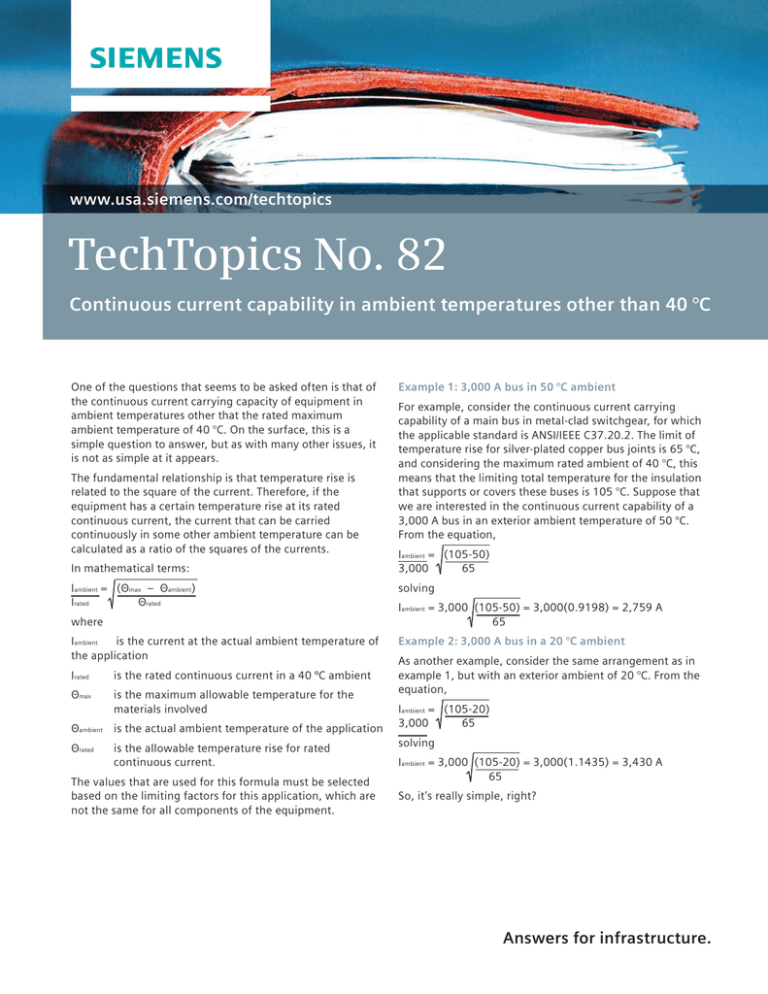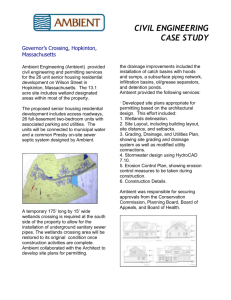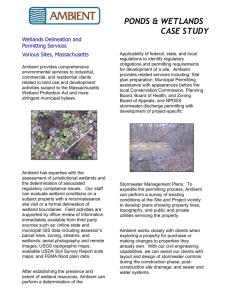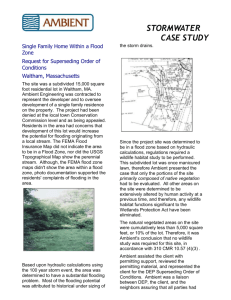TechTopics No. 82 www.usa.siemens.com/techtopics
advertisement

www.usa.siemens.com/techtopics TechTopics No. 82 Continuous current capability in ambient temperatures other than 40 °C One of the questions that seems to be asked often is that of the continuous current carrying capacity of equipment in ambient temperatures other that the rated maximum ambient temperature of 40 °C. On the surface, this is a simple question to answer, but as with many other issues, it is not as simple at it appears. The fundamental relationship is that temperature rise is related to the square of the current. Therefore, if the equipment has a certain temperature rise at its rated continuous current, the current that can be carried continuously in some other ambient temperature can be calculated as a ratio of the squares of the currents. In mathematical terms: Iambient = (Θmax ‒ Θambient) Θrated Irated where is the current at the actual ambient temperature of Iambient the application Irated is the rated continuous current in a 40 °C ambient Θmax is the maximum allowable temperature for the materials involved Example 1: 3,000 A bus in 50 °C ambient For example, consider the continuous current carrying capability of a main bus in metal-clad switchgear, for which the applicable standard is ANSI/IEEE C37.20.2. The limit of temperature rise for silver-plated copper bus joints is 65 °C, and considering the maximum rated ambient of 40 °C, this means that the limiting total temperature for the insulation that supports or covers these buses is 105 °C. Suppose that we are interested in the continuous current capability of a 3,000 A bus in an exterior ambient temperature of 50 °C. From the equation, Iambient = (105-50) 3,000 65 solving Iambient = 3,000 (105-50) = 3,000(0.9198) = 2,759 A 65 Example 2: 3,000 A bus in a 20 °C ambient As another example, consider the same arrangement as in example 1, but with an exterior ambient of 20 °C. From the equation, Θambient is the actual ambient temperature of the application Iambient = (105-20) 3,000 65 Θrated solving is the allowable temperature rise for rated continuous current. The values that are used for this formula must be selected based on the limiting factors for this application, which are not the same for all components of the equipment. Iambient = 3,000 (105-20) = 3,000(1.1435) = 3,430 A 65 So, it’s really simple, right? Answers for infrastructure. Remember, the discussion mentioned that this is not as simple as it may first appear. The reason is that there are various limiting temperatures and temperature rises in the equipment. For the metal-clad switchgear example, some of the limitations are: Description Bus, circuit breaker and other main currentcarrying parts Current transformers Cable connection pads (for outgoing cables) Allowable rise (°C) / ambient (°C) Reference 65/40 C37.20.2-1999, table 3 30/55 C57.13-2008, paragraph 4.4.2 and C37.20.2-1999, paragraph 5.6.3 45/40 C37.20.2-1999, table 3 Example 3: current transformers with 50 °C ambient Use the situation of example 1 with 3,000 A bus and with 50 °C exterior ambient, and consider the current transformers (CTs) in the circuit breaker cell. CTs have a rated temperature rise of 30 °C in an exterior ambient of 40 °C. For switchgear, the basis of rating of CTs is that the air inside the switchgear rises 15 °C above the ambient outside the switchgear, so the actual rated ambient inside the switchgear (the ambient for the CTs) is 55 °C. Also, the ambient has to be recalculated for the example, as in a 50 °C exterior ambient, the ambient around the CT would be 55 °C + (50 °C – 40 °C ) = 65 °C. Substituting in our equation: Iambient = (85-65) 3,000 30 solving Iambient = 3,000 (85-65) = 3,000(0.8165) = 2,449 A 30 What this shows is that when operating in an ambient above the rated 40 °C ambient, the component of the switchgear with the lowest temperature rise limitation is the most restrictive condition in the application of the product. In example 1, a capability of 2,759 A was calculated for the bus based on the 65 °C temperature rise limit in C37.20.2, but in example 3, a limit of only 2,449 A is found. How to manage this? It is actually very simple – merely use a higher primary current rating for the CT, for example, 3,500:5 or 4,000:5. Try it in the formula; for 3,500:5 the allowable current would be 2,858 A, while for 4,000:5, the allowable current would be 3,266 A. Of course, this does not change the limit on bus current calculated in example 1, but it changes the allowable limit for the CTs so that they are no longer the limiting factor. Example 4: current transformers with 20 °C ambient So, take the situation of example 2 with 3,000 A and with 20 °C external ambient, and consider the CTs in the circuit breaker cell. As in example 3, the rated ambient temperature for the current transformers is 55 °C. To get the ambient inside the switchgear for the current transformers, 15 °C must be added for internal air temperature rise to the external ambient of 20 °C. In the calculations, the resulting ambient for the CTs is 35 °C. Substituting in our equation: Iambient = (85-35) 3,000 30 solving Iambient = 3,000 (85-35) = 3,000(1.2910) = 3,873 A 30 This reinforces the lesson learned from example 3. In a situation of higher exterior ambient than the rated ambient of 40 °C, the component with the lowest temperature rise limit is the boundary restriction on allowable current. For the situation of a lower exterior ambient temperature than 40 °C, the components with lower temperature rise limits are no longer the boundary restriction. So, given 20 °C exterior ambient temperature, the main bus is the limiting factor, with an allowable current of 3,430 A, versus the theoretical limit of 3,873 A for the CTs. In the example of the 50 °C exterior ambient temperature, the current transformers were the limiting factor, at 2,449 A as compared to 2,759 A for the main bus. Summary Hopefully, the examples and mathematics in this issue of TechTopics have made the issue simple to understand. The underlying principle of the discussions is that the electrical life of switchgear or circuit breakers is determined by the temperatures to which the insulating materials are exposed (the reader might wish to review TechTopics No. 15 for more discussion on the life of insulating materials). So, the objective of all the mathematical gyrations is to produce limiting current capabilities that expose the insulating materials to the same total temperatures as they experience when operating at rated continuous current in a maximum ambient of 40 °C. For those so inclined, you may wish to check the calculation results in this issue of TechTopics by referring to the IEEE standard, C37.20.2, on metal-clad switchgear, table 10. The values in the calculations can be verified in this table, by referring to the relevant column in the table for the temperature rise limit of the component (reference IEEE C37.20.2-1999, “Standard for Metal-Clad Switchgear”). The information provided in this document contains merely general descriptions or characteristics of performance which in case of actual use do not always apply as described or which may change as a result of further development of the products. An obligation to provide the respective characteristics shall only exist if expressly agreed in the terms of contract. All product designations may be trademarks or product names of Siemens AG or supplier companies whose use by third parties for their own purposes could violate the rights of the owners. Siemens Industry, Inc. 7000 Siemens Road Wendell, NC 27591 Subject to change without prior notice. Order No.: E50001-F710-A459-V1-4A00 All rights reserved. © 2012 Siemens Industry, Inc. For more information, contact: +1 (800) 347-6659 www.usa.siemens.com/techtopics





